
HEATING/COOLING
Challenge
An arctic freeze has enveloped your community. Snow and ice have made roads impassable. Your heating unit unexpectedly shuts down, and it will be days before repairmen can service your home. Temperatures fall to dangerous levels each night. How will you keep your family warm?
There are numerous situations that can leave you without heating or cooling. In moderate climates, this may not be a serious concern, but most people are reminded annually of the bitter sting that winter brings. Staying warm becomes not merely a matter of comfort but one of survival. Conversely, there are places in the country where summer heat waves can bring suffering and even death if your home's temperature is not adequately controlled.
Simply put, getting too cold or too hot can kill you. At one end of the spectrum is hypothermia—literally freezing to death. At the other end is hyperthermia—overheating to the point of heatstroke. Both conditions are equally deadly and must be prevented.
If more heat escapes your body than it can produce, you will cool and eventually develop hypothermia. Normal body temperature is 98.6°F. If your internal core temperature drops below 95°F, it signals hypothermia. Symptoms may include gradual loss of motor skills and mental acuity, fatigue, mumbling, slowed breathing, slurred speech, and cold, pale skin. Since symptoms usually develop gradually, victims are often unaware that they are succumbing to the cold. If the condition is allowed to progress, it can lead to death. In the United States alone, nearly 700 people die from hypothermia each year.150
Being in extreme cold without adequate clothing, wearing wet clothes (especially in windy conditions), or being exposed to very cold water can all cause hypothermia. Treatment for hypothermia includes moving to a warmer environment, removing wet clothing, insulating from any cold surface, sharing body heat, and drinking warm beverages. Never massage the skin, apply direct heat using a heating pad or heat lamp, or drink alcoholic beverages.150
Prevention is best done by wearing clothing appropriate to the environment, including gloves, hat, and footwear. Avoid overexertion that can cause you to sweat. If you do become wet for any reason, change out of the wet clothes as soon as possible.

Paradoxical undressing is a hypothermic condition in which a person feels so hot that they undress.
Twenty to 50 percent of all deaths relating to hypothermia are associated with what is known as paradoxical undressing.151 Though the causes are not entirely understood, it is a condition in which a person feels extremely hot even though his core temperature is falling to deadly levels. The victim begins to shed clothing in an effort to cool off, which only further speeds his demise. Unfortunately, the confusion and impaired judgment caused by hypothermia keep the person from recognizing the cause of their self-destructive actions.
Hyperthermia is the condition in which your body absorbs or produces more heat than it can dissipate. The term is often used to describe several heat-related illnesses, including heat cramps, heat exhaustion, and heatstroke.
Heat cramps are the first stage of hyperthermia. Symptoms include profuse sweating, fatigue, thirst, and muscle cramps. Strenuous physical activity in hot weather is usually the cause, although exertion is not necessary if the environment is hot enough. Heat cramps can be treated by drinking fluids, especially those containing electrolytes, and resting in a cool location.
If you do not take the steps necessary to cool down when experiencing heat cramps, they will develop into heat exhaustion. You will become thirsty, giddy, weak, uncoordinated, nauseated, and continue to sweat profusely. Your body temperature will likely remain normal, but your pulse may become elevated, and your skin can feel cold and clammy. Heat exhaustion is a serious warning that you are getting too hot and need to immediately rest in a cool location and drink cold liquids.152
Continued exposure to heat or exertion could lead to heatstroke—a life-threatening condition. This occurs when your body temperature rises to 104°F or higher. Other symptoms may include cessation of sweating, hyperventilation (rapid, shallow breathing), muscle cramps, weakness, confusion, combativeness, irrational behavior, strong rapid pulse, and delirium. The high body temperature can cause irreversible brain damage, organ failure, and death.153
If you suspect you are suffering from heatstroke, get to a cool location and rest. Drink cold liquids, especially water and fruit juice, but avoid caffeinated or alcoholic drinks. If possible, shower, bathe, or sponge off with cool water. Additional medical attention may be necessary—see Chapter 10 for more treatment information.
It may be hard to believe, but humankind survived for a very long time without air conditioning (A/C). You can too by applying a little commonsense. If you find yourself without A/C, you can prevent heat-related illnesses by limiting your activities, drinking cold beverages, and establishing some basic air circulation in your home.
Consider the following suggestions to keep yourself cool:
• Take it easy. Give yourself permission to be lazy.
• Drink plenty of cold, non-alcoholic liquids.
• Wear loose-fitting, warm-weather clothing, such as shorts and a t-shirt.
• Enjoy a Popsicle, frozen fruit, or other icy treat.
• Soak your t-shirt in water and sit in front of a fan or breeze.
• Take a cold bath or shower.
• Stay in the lowest level of your home. Heat tends to rise to the upper levels. Better yet, sit under a large shade tree outside.
• Fan yourself—improvise as necessary with a magazine, piece of cardboard, or other lightweight flat object.
• Soak your feet in a bucket of cool water.
Consider the following suggestions to keep your home cool:
• Close your blinds on windows facing the sun.
• Open windows on opposite sides of your house to create air circulation. If possible, use fans to draw off heat from the hottest parts of your house, and pull in cooler air from outside.
• Turn off anything creating unnecessary heat (e.g., lights, computer, dishwasher, television).
• Run appliances in the evening when it is cooler.
• Blow air across a bowl full of ice cubes or water frozen in 2-liter bottles to create a mini air conditioner.
• As a longer-term solution, plant shade trees around your home.
Beyond these basic preventive measures, no other special preparations are usually necessary to stave off heat-related illnesses. For most families, there isn't a pressing need to maintain a secondary cooling system for the home.
With that said, if someone in your family is particularly susceptible to heat (perhaps an elderly parent, a young child, or even a pet), then you should plan accordingly. This usually means having backup electrical power to run fans or a small A/C system—see Chapter 6 for details on electrical preparations.

The elderly and children are particularly susceptible to overheating, so monitor them closely.
Keeping warm starts with having the right kinds of clothing and bedding. Your family should already have clothing appropriate to the climate in which you live, so additional garments aren't likely necessary. Bedding may be another matter. You are accustomed to maintaining a comfortable living environment by simply adjusting the thermostat. But what if that heat fails, and your home is left no warmer than the frosty outdoors? Your family's usual bedding probably won't be enough to stay warm at night.
The easiest way to prepare is to consider what your family would need to spend the night outdoors. Winter sleeping bags, down comforters, and heavy wool blankets should all come to mind. How much and what kind depends on where you live. Whatever blankets you select, plan as if Jack Frost is maliciously working against you—worst winter on record, heating system failure, a couple of windows broken out. Unrealistic yes, but keeping warm is critically important and not overly difficult to do with a few basic preparations. You can't go wrong by having extra blankets. If you end up not needing them, loan them to neighbors or friends who might be less prepared. Also, remember to stash blankets in the car for roadside emergencies—see the auto kits described in Chapter 13 for more information.

When planning for cold weather, prepare for a worst case scenario.
If you want to do much more than huddle under blankets, you will need some kind of area heating. Not only will heating help your family to function, but it will also help them to feel more comfortable—and that leads to a happier family.
Heat can be lost in two very different ways, and each requires different preparations. The first is a disruption in your fuel source. For most people, this is manifested through a loss of electrical power or the shutting off of the gas supply. The second is when your heating unit fails, perhaps due to cold weather or just a case of bad luck. Regardless of the cause, a reasonable goal is to have sufficient heating supplies to support your family for a minimum of two weeks.
Many situations can result in your heating system's fuel source being unavailable, whether that fuel is electricity, propane, or natural gas. For these occasions, you need a supplementary source of fuel and a method to use it in your heater. Depending on the type of heater, this provision is handled in different ways.
If you have an electric heating system, you can probably power it using a large generator. Take care to size the generator to handle both constant and surge current requirements—see Chapter 6 . If your heater burns propane or natural gas, you will need a backup fuel tank and a valve that allows you to switch over to that secondary source. You will also likely need a small backup electrical source to power the blower motor, thermostat, ignition system, and backup strip heating. This necessity can usually be met with a small generator or a battery and inverter.
If you have a wood-burning stove, kerosene heater, or other local heat source, you will probably not be directly affected by the centralized disruption of fuel. But once again, you may still require modest levels of electrical power for the blower or pellet auger. Investigate your particular system to fully understand its operational needs.
If you have ever witnessed the numerous repair trucks servicing neighborhoods during a cold spell, you realize how frequently heating systems fail. This is especially true when the weather is unusually frigid, and the heater is worked harder than usual.
To be prepared for a heating system failure, you will need a backup heat source. Due to costs, having a fully redundant secondary heating system is probably not feasible. Instead, you may opt to have a smaller backup heater that is capable of heating only a portion of your home—enough to help you get by until your system can be serviced. There are many options for backup heating, including kerosene heaters, electric space heaters, and wood-burning stoves, all of which are discussed later in this chapter.

Due to cost constraints, you may opt for a backup heating system that heats only an isolated area of your home.
Personal aside: On three separate occasions, and at three different residences, my family's heating system failed during harsh winter storms. In all three cases, I was unable to get a service person out to my house in less than forty-eight hours—leaving us to fend for ourselves. The first time, my family and I were ill prepared and had little choice but to abandon our house and seek a warm hotel. When the second incident occurred, we had enough blankets and knowhow to weather the event, albeit with a few shivers. By the third time, my family was equipped with a kerosene heater, a wood-burning fireplace, and stacks of blankets—making our home a welcome neighborhood refuge.
Before considering backup heat sources, realize that the dangers of im-proper use far outweigh the dangers of freezing to death. Two significant risks are worth noting: carbon monoxide (CO) poisoning and fire.

When it comes to heaters, the dangers of fire and carbon monoxide poisoning far outweigh the dangers of freezing.
Any type of heater that burns fuel, such as wood, coal, propane, and kerosene, also produces CO. Carbon monoxide is a colorless, odorless gas, so you won't see or smell it. Symptoms of CO poisoning include headache, fatigue, lightheadedness, shortness of breath, nausea, and dizziness. If you experience any of these symptoms while operating fuel-burning heaters, get fresh air immediately! Carbon monoxide poisoning is deadly, killing about 200 people in the United States each year.114 The surest way to prevent CO poisoning is never to use fuel-burning appliances indoors without proper ventilation. It is also a good idea to put a CO detector in any room where a fuel-burning appliance is used (see Chapter 4 for a discussion of safety devices).

All unvented fuel-burning heaters require ventilation: 1 square inch per 1,000 BTUs
Using a fuel-burning heater requires either direct venting to the outdoors using a pipe that routes through the wall or ceiling or keeping the area well ventilated with open windows or doors. Most heaters come with manufacturer's recommendations regarding ventilation. Read and follow them. If recommendations are not furnished, a useful rule of thumb is to provide one square inch of window opening for each 1,000 BTUs of heater rating.154 For example, a heater with a 20,000 BTUs/hour rating would require that a 10-inch wide window be open 2 inches (i.e., 20 square inches of opening). This recommendation should be treated as the minimum ventilation for all fuel-burning heaters that are not directly vented outdoors.
The second risk of using a fuel-burning heater is that you might catch your house or shelter on fire. Heaters must be kept away from flammable materials, and that means basically everything in your home except stone, metal, or brick. Normal construction materials, such as sheetrock, wood flooring, and carpet, as well as furniture, clothing, and bedding can all catch fire from backup heaters. The hotter the heater, the more likely it is to cause a fire. For this reason, never leave heaters unattended, and solicit help from everyone involved to keep a watchful eye.

Preventing Heater Fires
1. Keep the heater away from anything flammable.
2. Never leave the heater unattended.
3. Explain the dangers to everyone involved, and ask them to help keep a watchful eye. Be especially mindful of very young children who might tip the heater or burn themselves.
4. If the heater plugs into the wall, avoid using extension cords. If you must use one, select a heavy duty cord with at least 14 AWG wire.
The amount of backup heat you need is largely determined by the climate in which you live. It is safe to say that if you live in Florida, you will need less backup heating than someone who lives in North Dakota. However, in all but the most temperate climates, some form of backup heat is advisable.
Start by assessing your current heat source. Does your house or apartment use a heat pump, gas furnace, or electric heater? If your heater burns fuel, such as natural gas or propane, does it also require electricity to power a blower? Perhaps you are out in the country and use a wood-burning stove or kerosene heater. If your primary fuel source was interrupted in the dead of the winter and remained out for two weeks, how would your family stay warm? The time to address this question is now while comfortably sipping iced tea, not when you can see your breath in the air.
Regardless of what type of secondary heating system you select, the first step is to conserve heat. Keep your house well sealed unless you are specifically using an unvented, fuel-burning heater. If you add up the gaps in an average home, they total about 14 square inches, and those gaps result in significant energy loss.155 Obvious corrective actions include applying weatherstripping around leaky doors and window sashes, caulking gaps and joints, and using double-paned windows.
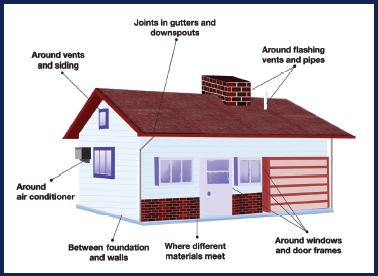
Weatherproofing your home
Conserve heat by weatherproofing your home: seal gaps, insulate windows, and weatherstrip around doors.
When considering the type of backup heater to use, many factors will come into play, including cost, safety, heating area, and the climate in which you live.
Seven steps for selecting and readying a backup heating system are:
1. If your backup heater cannot heat your entire home, identify a well-insulated space in your house to where your family will retreat. It should have limited windows or doors to the outside, but easy access to a bathroom. If you decide to consolidate in the main living area of your home, seal off adjoining rooms.
2. Determine how much heat you will need (see “Sizing Your Heater”).
3. Select the most appropriate type of heater for your situation (see “Types of Heaters”).
4. Learn how to safely use your heater.
5. Install any necessary venting or duct work.
6. Stockpile the necessary fuel.
7. Test your heater on a very cold winter day to ensure it will meet your family's needs. Supplement or resize the heater as necessary.
There are heaters available in nearly every size; some are big enough to heat a barn, while others are barely able to warm your feet. Properly sizing your backup heater can mean the difference between being cozy and being miserable.
Sizing a heater requires you to consider three things:
• The volume of air to be heated
• The heat that escapes through the walls, floor, and ceiling
• The minimum allowable temperature difference between indoors and outdoors on the worst possible winter day
If you're installing a large, fully-redundant heating system, such as a heat pump or furnace, have the retailer inspect your home to determine the correct heater size.
If you opt for a smaller, localized heat source—perhaps a wood-burning stove, kerosene heater, or electric space heater—you will need to determine the necessary heater size by making a few measurements and performing some simple calculations.
There are many online tools and resources to help you perform heater sizing.156,157,158,159 Unfortunately, their methods and results frequently disagree. That is because precise heater sizing requires detailed knowledge of your home's exposure, orientation, insulation, sealing, and air flow. Each tool makes different assumptions, some more conservative than others.
The following guidelines are considered to be reasonable methods of estimating the required size of a heater. The three methods discussed are in order of increasing accuracy.
The simplest method to size a heater is to multiply the square footage to be heated by 25. The result is the number of BTUs/hour needed to stay warm.
For example, if you wish to heat 200 square feet, you would need a heater capable of outputting a minimum of:
200 × 25 = 5,000 BTUs/hour
A second slightly more accurate method requires measuring the volume of air to be heated and specifying the minimum temperature difference desired between your home and the outdoors. Once again, a straightforward equation can be used to estimate the heater size:
Volume × ΔT × 0.133
For example, to heat a room measuring 200 square feet and having 8-foot ceilings, would require heating 1,600 cubic feet of air. If the outside temperature can fall as low as 10°F, and you wish to maintain the inside temperature at 60°F, the temperature difference is 50°F. The minimum heater size then would be determined to be:
1,600 × 50 × 0.133 = 10,640 BTUs/hour.
An even more accurate method takes into account your home's level of insulation, but no longer considers the specific temperature difference you are trying to achieve. This method has you multiply the size of the area to be heated by an insulation factor (given in Table 7-1):
Area × Insulation Factor
For a house with average insulation, heating a 200-square-foot area would require between:
Best case: 200 × 50 = 10,000 BTUs/hour
Worst case: 200 × 70 = 14,000 BTUs/hour
Table 7-1 Insulation Factors160
Category |
Insulation |
Factor |
Poor Insulation |
No insulation in walls, ceilings, or floors; no storm windows; windows and doors not well sealed |
90–110 |
Average Insulation |
R-11 insulation in walls and ceilings; no insulation in floors; no storm windows; doors and windows fairly tight |
50–70 |
Good Insulation |
R-19 insulation in walls, R-30 in ceilings, R-11 in floors; tight-fitting storm windows or double-pane windows |
29–35 |
Super Insulation |
R-24 wall insulation, R-40 in ceilings, R-19 in floor; tight-fitting storm windows or double-pane windows; vapor barrier sealed carefully during construction |
21–25 |
Earth-sheltered |
Earth-sheltered house with little exposure; well insulated |
10–13 |
As you can see, the three estimates range anywhere from 5,000 to 14,000 BTUs/hour. With these methods you can get a first-order estimate of your heating needs (perhaps by taking the average of the three). Once you have that estimate, you will need to select a heater that functions well in your house for the temperature extremes you are likely to experience. This can often be a process of trial and error—buying a heater that you think will work, and then supplementing or replacing it as needed.
Most heaters are specified by British Thermal Units per hour (BTUs/hour). Sometimes retailers will get sloppy and simply state the value as BTUs, but they are always referring to BTUs/hour. A BTU is defined as the amount of heat required to raise one pound of water one degree Fahrenheit. It makes sense that a heater should be rated by how much heat per hour that it outputs.

Sizing a secondary heater can often be a process of trial and error.
Electric heaters are an exception to this method of specification. They are sized in watts rather than BTUs/hour. For comparison purposes, you can convert from watts to BTUs/hour by multiplying the number of watts by 3.4. For example, a standard 1,500-watt electric space heater will output heat comparable to a 5,100-BTUs/hour propane heater. There are other considerations to make this conversion more accurate, such as energy efficiency, but the factor of 3.4 is a reasonable estimate.
Another method to size an electric heater is to assume that every square foot requires about 10 watts of power.161 This is not precise and does not consider cubic feet or temperature drop, but it gives a preliminary estimate. Using this method, a 200-square-foot room would require 2,000 watts of electric heating (or roughly 6,800 BTUs/hour).
There are many possible sources of backup heat, each with its respective advantages and disadvantages. A list of likely candidates is given in the tip box.
Regardless of the type of heater you select, you should fully understand the dangers associated with it. If you select an electric, propane, or kerosene space heater, pick a unit that has an automatic shutoff feature in case it is accidentally tipped over. It is worth repeating that any heater that burns fuel, whether it is wood, propane, kerosene, or gas, must either be vented to the outdoors or reside in a well-ventilated room to prevent carbon monoxide buildup.

Backup Heaters
 Fireplaces
Fireplaces
 Masonry heaters
Masonry heaters
 Wood/Coal/Pellet stoves
Wood/Coal/Pellet stoves
 Electric space heaters
Electric space heaters
 Kerosene space heaters
Kerosene space heaters
 Oil-filled radiators
Oil-filled radiators
 Propane or natural gas heaters
Propane or natural gas heaters
Modern fireplaces typically come with artificial logs and glass covers and are designed more for style than heat. They offer a wonderful instant fire ambiance, but unfortunately, they don't output much heat to the room. To improve their utility, many instant-on fireplaces can be equipped with internal blowers that help to circulate the heat. If using blowers, don't forget to address this requirement in your electrical power preparations.

Fireplaces are terribly inefficient, but using a Texas Fire Frame can help.
If you have a traditional stone or brick wood-burning fireplace, then you can get a little more heat from it—but not much. Wood-burning fireplaces are very inefficient, losing about 90 percent of their heat up the chimney.162 This can be improved through the use of a “Texas Fire Frame” or other fireplace radiant grate that focuses heat back into the room, perhaps raising the efficiency up to 30 percent. Another option is to install a wood- or pellet-burning stove insert into the fireplace. Stoves inserts significantly improve the efficiency as well as reduce smoke emissions.
Texas Fire Frame
Modern masonry heaters are based on traditional designs dating back to the fourteenth century. They are known by many names, including Russian stoves, Kachelofen, Tulikivi, Grudofen, and Contraflow heaters. Each heater consists of a large stone or brick burn box, a chimney, and a labyrinth of channels to trap the heat and smoke. This trapped heat is transferred to the masonry hearth and surrounding walls. The fire itself only burns for a brief period of time, but the heat is radiated out from the masonry for twelve to twenty-four hours, meaning that only a single fire may be needed for an entire day's heat. This slow, steady release of heat is the primary advantage of masonry heaters over other heating methods.
Masonry heaters typically burn wood, but they have also been used to burn straw, dry vegetable matter, and even garbage. The fire burns very hot (over 1,400°F), leading to complete and rapid fuel consumption that releases very little air pollution. Despite the high temperature, the surrounding stone is massive enough not to be hot to the touch. The heaters offer exceptional (80–90 percent) efficiency because most of the energy is trapped in the masonry rather than vented up through the chimney.

Even with a small morning fire, masonry heaters radiate heat throughout the entire day.
However, there are several drawbacks to masonry heaters. They require a couple of hours to heat up, which can be a long wait on a cold winter morning. They also do not have centralized heat distribution, leaving most of the radiant heat to remain in the room with the heater. Finally, anyone considering a masonry heater must take into account their weight and cost. The stonework can easily weigh two thousand pounds or more, often requiring that the floor be reinforced. Masonry heaters are custom built by expert craftsmen and can cost many thousands of dollars. Additional information and a listing of licensed builders can be found online at the Masonry Heater Association of North America.163

Courtesy of Bob Weaver Masonry
Coal, pellet, and wood stoves are in many ways the epitome of disaster preparedness. In many cases, they can serve as both heater and stove—meeting two very important needs simultaneously. Some stoves fit into existing fireplaces as inserts, while others are free-standing. Newer models control the oxygen level so that fuel lasts longer and burns more completely, making them more efficient and less polluting than stoves of the past. Stoves are excellent backup heaters, but they are fairly expensive, require periodic maintenance, and professional installation is definitely recommended. There are many vendors for fuel-burning stoves, including Woodstock Soap-stone Company, Lopi, Harman, Napoleon, Reading Stove Company, Lehman's, and Vermont Castings.
Coal stoves emit more pollution than EPA-certified wood stoves. The primary advantage of a coal stove is its higher fuel efficiency and lower fuel costs. Table 7-2 gives a useful comparison of fuel efficiencies and costs for many types of vented room heaters. This table makes clear the advantage of coal over other fuels since costs can be half those of a pellet stove or one-third those of electric power.
Much like masonry heaters, coal and wood stoves allow burning of improvised fuels (e.g., lumber scraps, furniture, newspapers, books). However, when burning makeshift fuels, pay attention that the chimney doesn't become clogged and catch fire. Burning wood in a coal stove is generally acceptable, but burning coal in wood or pellet stoves will quickly deteriorate the stove floor due to the higher burn temperatures.

Wood can be burned in coal stoves, but not vice versa.
Pellet stoves are designed to burn cleaner and more efficiently than conventional wood stoves. They burn short, thin rods of compressed sawdust or other renewable materials. These “pellets” are poured into a hopper that feeds automatically into the stove, typically using an internal electric auger. Note that these stoves can be picky about the types of pellets they will handle without jamming, so be sure to experiment with products before stocking up.165 Pellet stoves emit very little pollution and therefore do not require EPA certification.
There are two types of wood stoves: catalytic and non-catalytic. Most stoves are non-catalytic, which means they are essentially large metal fireboxes with baffles. Catalytic stoves are a bit more complicated since they pass the smoky exhaust through a coated, ceramic honeycomb inside the stove where the smoke gases and particles burn. The honeycomb elements must be replaced every two to six years. Catalytic stoves also come equipped with a lever-operated bypass damper that is opened when starting or reloading.
Be sure to do your homework and select an EPA-certified stove that provides adequate heat output and burns the fuel you have selected. The EPA's smoke emission, efficiency, and heat output ratings (in BTUs/hour) are listed on the back of certified stoves. Modern wood-burning stoves emit much less smoke than older stoves. For a stove to be EPA-certified, particulate emissions must be below 7.5 grams per hour for non-catalytic wood stoves and 4.1 grams per hour for catalytic stoves. (Some states impose even more restrictive limits.) Compare this to previous-generation stoves that emitted between 15 and 30 grams per hour.166
When researching stoves, don't just read product descriptions; check user reviews to see what types of problems others have experienced. Also, visit the retailer and personally inspect each stove for durability and quality. This is an investment that your family will benefit from for many years, so take the time to make a well-informed selection.

Select an EPA-certified stove to ensure minimal emissions.
If you are relying on a wood-burning stove, either as your primary heat source or as a backup emergency heater, you will need to determine your fuel needs. Wood is purchased in cords, with each cord measuring 4 feet × 4 feet × 8 feet. A cord should consist of tightly-stacked, cut wood. Most of the time, individual wood pieces are sold in lengths smaller than 4 feet to facilitate easier burning. The amount of energy in a cord of wood can be compared to other fuel sources as shown in Table 7-3.
Fuel Type |
Equivalent Quantity |
Wood |
1 cord |
No. 2 Fuel Oil |
150 gallons |
Liquid Propane |
230 gallons |
Natural Gas |
21,000 cubic feet |
Electricity |
6,158 kilowatt-hours |
Using these equivalence values and the fuel efficiencies given in Table 7-2, you can determine the number of cords of wood needed to meet your heating needs:

PF is the amount of primary fuel used, W is the wood equivalence number from Table 7-3, and EPF and EW are energy efficiencies of the primary fuel and wood (given in Table 7-2).
Example: Assume your 2,000-sq. foot home normally uses 60,000 cubic feet of natural gas per year. The efficiency of natural gas is about 65 percent, and the efficiency of wood is about 55 percent. The number of cords of wood needed to supply your heating needs for a full year would be given by:

Electric space heaters are inexpensive and easy to use; simply plug them in and set the desired output level or thermostat temperature. They obviously require electricity, provided either by your electric company, a generator, or an inverter and battery combination. The Electrical Code limits the size of residential electric heaters to a maximum of 1,500 watts. If you need more heat than that, you must use multiple heaters. Each heater should be plugged into a different circuit in your home (e.g., one in the living room outlet, one in the kitchen—assuming they are on separate breakers). If you plug two heaters into the same circuit, they will almost certainly overload and trip your breakers.

Cord of Wood

Plug each electric heater into a separate circuit to prevent overloading your breakers.
If you have consolidated your family to a small area, even a single 1,500 watt electric space heater may be adequate to keep warm. This depends on the size of the room, the insulation, and how cold it is outside. Electric heaters do not emit carbon monoxide. However, as with all heaters, ensure that there is adequate space around the heater to prevent a fire.
Features to look for in an electric space heater include:
• Automatic shutoff when tipped over
• Overheat protection
• Long power cord to allow easier placement of the heater
• Thermostat or multiple output settings
• Circulating fan (for convection models)
The two most common types of electric space heaters are convection and radiant. Convection heaters flow air across a hot thermal conductor (usually ceramic plates or metal coils). Air is circulated into the room either naturally through convection or by an electric fan. Convection heaters are useful for heating small rooms.
Radiant heaters produce directional heat using an element, such as quartz, and a reflector. They are best suited for heating a small area directly in front of the heater because very little heat is radiated at any other angle. The heat is immediate but dissipates quickly when the unit is turned off.
There are many manufacturers of electric space heaters including Bionaire, Soleus, DeLonghi, Duraheat, Honeywell, Vornado, Presto, and Lasko.
Kerosene heaters can either be vented or unvented. Larger units generally feed directly from outdoor kerosene tanks and vent back outside through pipes (similar to wood stoves). Smaller, unvented units have modest kerosene tanks attached directly to the unit and are meant to heat one or two rooms. Beware that the term “unvented” is misleading. Like all fuel-burning appliances, unvented kerosene heaters consume oxygen and emit poisonous fumes, meaning that venting of the room is still required. Kerosene heaters also emit an odor that many people find unpleasant—some heaters worse than others.
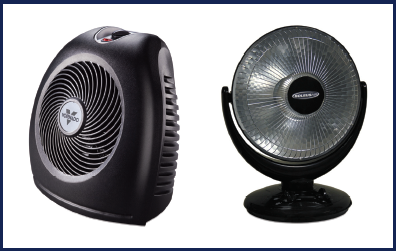
Vornado convection and Soleus radiant heaters
Portable, unvented kerosene heaters generate significant heat, most outputting from 10,000 to 30,000 BTUs/hour. Surface temperatures can reach up to 500°F, so use caution and keep children a safe distance away from them.
Below are additional safety recommendations for using kerosene heaters:154
1. Use heaters that have been tested and listed in accordance with Underwriters’ Laboratories (UL) Standard 647. This compliance should be present on the nameplate.
2. Use 1-K kerosene fuel, which has about 1/8 the sulfur content of 2-K kerosene. The use of 2-K kerosene leads to increased sulfur dioxide emissions and frequent wick maintenance. The terms “water clear” or “clear white” are often used to describe 1-K kerosene. Never use diesel fuel, gasoline, jet fuel, or No. 1 fuel oil in a kerosene heater.
3. Keep heaters at least 36 inches from anything combustible.
4. Perform periodic maintenance, including cleaning the unit, trimming the wick, and inspecting for fuel leaks.
5. Ensure adequate ventilation. Follow the manufacturer's guidelines. If recommendations are not given, provide a minimum of one square inch of window opening for each 1,000 BTUs of the heater rating.
6. Don't operate kerosene heaters when everyone is asleep. A malfunction could lead to asphyxiation.
7. Allow the heater to cool a minimum of fifteen minutes before refueling. If kerosene is spilled onto a hot heater it can ignite and cause a fire. Also, refuel the heater outside in a well-ventilated area. Don't overfill it; leave a space at the top for fuel expansion.

Sengoku kerosene heater
8. Keep fuel outside of the main living area, stored in approved blue safety containers with “kerosene” clearly marked on them.
9. Have smoke and CO detectors in the area being heated, as well as fire extinguishers nearby.
Manufacturers of kerosene heaters include Sengoku, KeroSun, Toyostove, and Corona.
Oil-filled radiators are sealed metal canisters filled with heating oil. When the heater is plugged into AC electrical power, the oil heats up and warms the air around the radiator. Oil-filled radiators have many advantages: they are easy to use, provide convective heat in all directions, are equipped with thermostats, and do not emit carbon monoxide. They are the safest of all space heaters and are the only type recommended to leave running while asleep. With outputs ranging from 600 to 1,500 watts, radiators are best suited to heating small rooms. Heat output is much slower than from electric or kerosene heaters, but radiators stay warm long after power is turned off. Manufacturers include Pelonis, Honeywell, Lakewood, and DeLonghi.

Oil-filled radiators are considered safe enough to use even while sleeping.
Portable propane heaters are a relatively new addition to space heaters. They come in many different sizes. There are large, outdoor units that provide up to 400,000 BTUs/hour of heat and run off 100-lb. tanks. These units are not meant to be used indoors, being better suited to sporting events, barns, or construction sites.
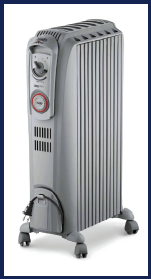
DeLonghi oil-filled radiator
There are also smaller hand-carried heaters that use standard 1-lb. or 20-lb. propane tanks. They typically output between 4,000 and 18,000 BTUs/hour. Small units can be used indoors as long as ventilation rules are followed—check the owner's manuals. If no specification is given in the owner's manual, allow a minimum of one square inch of ventilation for every 1,000 BTUs of heat.

Portable propane heaters can be a quick “grab-n-go” heating system.
The small, portable propane heaters offer the unique advantage of providing heat on the go. You can quickly pack the heater and a few bottles of propane and take them on the road. However, be aware that 1-lb. propane tanks may only last a few hours, so be sure to stock enough fuel. If you decide to use portable propane heaters, invest in a disposable tank adapter that allows you to refill 1-lb. bottles from a 20-lb. tank.
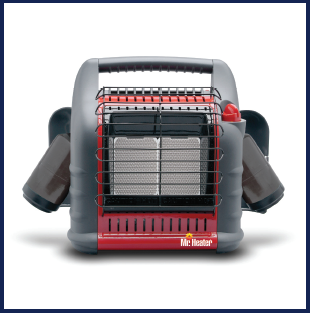
Mr. Heater propane heater
Water expands when it freezes and, as any homeowner who lives in a cold climate can attest, this expansion can crack pipes. The most susceptible pipes are those directly exposed to the cold, including sprinkler and swimming pool supply lines and your home's main water line. However, pipes in exterior walls or unheated areas of your house, such as in the basement, attic, garage, or crawlspace, are also prone to freezing.
Depending on the size of your backup heating system, it may or may not keep the temperature of your entire home above freezing. If it doesn't, then some of your water pipes may freeze. This is an important consideration since being without water makes a bad situation far worse.
Below are several recommendations to help prevent pipes from freezing.167
Before the cold arrives:
• Drain sprinkler and pool supply lines.
• Remove, drain, and store hoses.
• Cut off the water supply to external hose spigots. If that is not possible, cover hose spigots with insulating covers.
• Insulate all exposed pipes using fiberglass, pipe sleeves, or heat tape.
When the cold arrives:
• Keep your garage doors and crawlspace access panels closed to keep in any available heat.
• Open kitchen and bathroom cabinet doors to allow house heat to warm the pipes in the walls more efficiently.
• Let water trickle from several faucets, especially overnight.
• If you have heat available, keep the thermostat set no lower than 55°F.
• Consider turning off the water entering your house, and draining your house pipes until the worst of the cold has passed. To do this, cut off the main line (typically located in your yard somewhere). It may require a special tool that can be purchased at most home improvement and hardware stores. An alternative is to use the interior cutoff (sometimes in the garage or a nearby closet), but the water may still freeze as it comes into your home. Once you cut off the flow of water, turn on all faucets until the water drains out of the interior house pipes.
After the cold passes:
• If your pipes freeze but don't crack, turn on your faucets and leave them open giving the pipes a way to flush themselves.
• If you can access the frozen pipe, try thawing it with a hair dryer or small electric heater—don't use a propane torch.
Cooking and heating are often related preparations because the two can frequently be used interchangeably—stoves can be used to heat the house; fireplaces can be used to cook food. At a minimum, you should try to select cooking and heating equipment that uses the same type of fuel. This helps alleviate the burden of multi-fuel storage and allows you to use your limited fuel for the more pressing of the two needs.

Consider using the same type of fuel for cooking and heating.
There are several ways to do small scale cooking in an emergency. They include using a fuel-burning stove, fireplace, barbeque grill, microwave oven, camp stove, or solar oven.
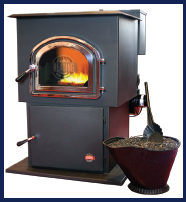
Courtesy of Reading Stove Company
Many coal, wood, and pellet stoves have flat surfaces that are intended for cooking. This design is a great combination since it takes care of two very important needs with one appliance. These stoves generally don't allow traditional baking, limiting you to stovetop cooking. The disadvantages include high initial setup cost, difficulty in regulating temperature, and the need to store large quantities of fuel. But even with their limitations and drawbacks, fuel-burning stoves are an excellent method of providing both heat and a means of cooking.
If you are going to cook over a fire, you will need some way to support the food. In the case of a fireplace, it is easiest to install a swinging-arm crane that folds out and allows you to hang a pot directly over the fire. A heavy, fire-safe pot, such as a Dutch oven, is definitely recommended since fire can wreak havoc on regular cooking equipment.
Likewise, when cooking over an open fire, you can either cook using a cast iron support tripod or a folding camp grill that straddles the fire.
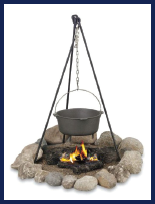
Texsport campfire tripod
Americans love a good barbeque. When the power fails, breaking out the grill can be an excellent way to cook. One particular benefit of the barbeque grill is that you are probably already proficient with it. A good grill master knows not only how to prepare meats, but also fresh vegetables, foil-wrapped dinners, and food in a heavy pot.
If you are not experienced at cooking over the grill, there are numerous cookbooks available to teach you the necessary skills. Depending on the model of grill, you will need either a supply of propane or natural gas, or charcoal briquettes and starter fuel. Barbeque grills should only be used outdoors because they release deadly carbon monoxide. Never use them inside your home or garage, even with the windows or doors open.
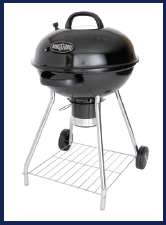
Masterbuilt grill
You may have never considered your microwave oven to be an emergency cooking source, but it does offer several advantages. Most units require only 800 to 1,000 watts of electricity, well within the range of a small generator or inverter—see Chapter 6. Microwave ovens cook very quickly and consume far less power than a range or conventional oven. If you rely on a microwave oven to be your backup cooking source, become proficient ahead of time at preparing many different types of foods.
Camp stoves are portable cooking units fueled by small propane canisters or tanks. Some stoves can burn a host of different fuel types, including white gas, kerosene, diesel, and jet fuel. Smaller stoves are little more than a single burner centered over a fuel canister. Larger units resemble a conventional stove top with multiple burners and fit the needs of a family better.
The main advantage of a camp stove is its portability—great for packing up and taking with you on the road. One thing to note about any portable stove that burns fuel is that it is not safe to use indoors. Also, store the compressed fuel canisters or tanks in a safe place that is cool and dry.
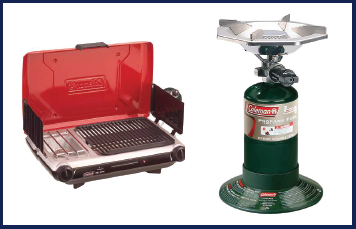
Coleman camp stoves
You might think that cooking with the sun is the stuff of survivalist lore. In reality, solar ovens that can cook a daily meal using nothing more than the sun do exist.
The advantages of solar ovens are easy to identify: they use free energy, don't release any poisonous gases, and can be used to cook just about anything that your conventional oven can. But alas, nothing is perfect. The disadvantages are equally significant. Solar ovens cook significantly slower than other stoves, hours of direct sunlight are required, and winds can cool the food or disturb the reflectors.
Slow cooking can be partially offset by cutting the food into bite-sized pieces, and careful placement of the oven can remedy wind disturbances. The need for sunny days, however, precludes the solar oven from serving as a reliable, backup cooking source.
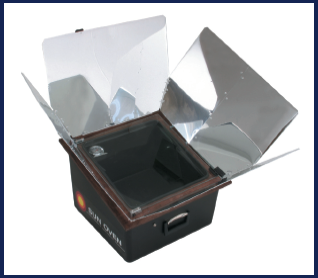
Sun Ovens International solar cooker
 Hypothermia is caused by allowing your body to get too cold. Likewise, hyperthermia is a result of your body getting too hot. Both conditions can be deadly.
Hypothermia is caused by allowing your body to get too cold. Likewise, hyperthermia is a result of your body getting too hot. Both conditions can be deadly.
 Keeping cool can be accomplished by limiting your activities, wetting yourself down, drinking cold liquids, and establishing some basic air circulation in your home.
Keeping cool can be accomplished by limiting your activities, wetting yourself down, drinking cold liquids, and establishing some basic air circulation in your home.
 When stockpiling blankets, consider the worst case scenario. Extra blankets can also benefit less-prepared neighbors or family members.
When stockpiling blankets, consider the worst case scenario. Extra blankets can also benefit less-prepared neighbors or family members.
 Heat can be lost in two ways: a disruption in your fuel source, or a failure of your heating unit. You must be prepared for either one.
Heat can be lost in two ways: a disruption in your fuel source, or a failure of your heating unit. You must be prepared for either one.
 Carbon monoxide poisoning, fire, and burns are very real dangers associated with backup heaters. Take the necessary precautions including installing CO alarms and fire extinguishers, and training everyone on how to safely operate the heater.
Carbon monoxide poisoning, fire, and burns are very real dangers associated with backup heaters. Take the necessary precautions including installing CO alarms and fire extinguishers, and training everyone on how to safely operate the heater.
 Several methods exist to estimate the size of your secondary heater. Use them to establish a rough estimate of your heating needs. Trial and error is often needed to get the size right.
Several methods exist to estimate the size of your secondary heater. Use them to establish a rough estimate of your heating needs. Trial and error is often needed to get the size right.
 Many backup heating options exist, including fireplaces, masonry heaters, fuel-burning stoves, and space heaters.
Many backup heating options exist, including fireplaces, masonry heaters, fuel-burning stoves, and space heaters.
 Coal, wood, and pellet stoves are the epitome of disaster preparedness because they reliably serve two vital needs.
Coal, wood, and pellet stoves are the epitome of disaster preparedness because they reliably serve two vital needs.
 Backup cooking can be accomplished with a fuel-burning stove, fireplace, barbeque grill, microwave oven, camp stove, or solar oven.
Backup cooking can be accomplished with a fuel-burning stove, fireplace, barbeque grill, microwave oven, camp stove, or solar oven.
Recommended Items—Heating/Cooling
 A method to stay warm while asleep
A method to stay warm while asleep
a. Heavy blankets and/or sleeping bags
 An emergency heat source
An emergency heat source
a. Fireplace with Texas Fire Frame, or
b. Masonry stove, or
c. Coal, wood, or pellet stove, or
d. Propane, kerosene, oil-filled, or electric space heater
 Fuel for emergency heater and backup stove
Fuel for emergency heater and backup stove
a. Coal, wood, pellets, or
b. Gas or diesel for a generator, or
c. Kerosene, propane, or natural gas
 Backup stove or oven
Backup stove or oven
a. Coal, wood, or pellet stove, or
b. Fireplace with swinging-arm crane, or
c. Barbeque grill, or
d. Microwave oven, or
e. Camp stove